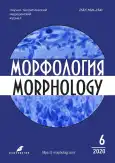卷 158, 编号 6 (2020)
- 年: 2020
- ##issue.datePublished##: 15.11.2020
- 文章: 4
- URL: https://j-morphology.com/1026-3543/issue/view/5231
- DOI: https://doi.org/10.17816/morph.20201586
完整期次
Reviews
Stem cells and fundamental problems of classical histology
摘要
The paper summarizes modern concepts of stem cells, considers their classification, the importance for the fundamental purposes of cell biology and clinical medicine, and shows the contradictions between the concepts of classical histology and modern information about stem cells. It also discusses the role and significance of the basic concepts of stem cells for the development of regenerative medicine. The question is raised on necessity of arrangement in the medical institutes of the course on stem cells and cellular technologies.
 139-150
139-150


Original Study Articles
Histomorphological changes in baker’s cyst tissues associated with the duration of one-directional thermal exposure
摘要
AIM: To identify and describe micro- and ultrastructural thermally induced changes in Baker’s cyst wall associated with the duration of unidirectional uniform heating at 70°C.
MATERIALS AND METHODS: We took one full-thickness fragment from each of the 15 Baker’s cysts excised during the operation and divided each fragment into four parts: one was used as a control sample, and the remaining three fragments were placed with the synovial membrane on a thermostat heated to 70°C, with exposure times of 60, 120, and 180 seconds. We used light-optical and electron microscopes for the histomorphological examination of the samples.
RESULTS: Two layers of Baker’s cyst wall were identified: inner (synovial) and outer (fibrous). In samples exposed to heat for 60 seconds, the synovial layer was undamaged. In samples exposed to heat for 120 seconds, thermal damage to the cells of the synovial layer and underlying collagen fibers of the fibrous layer was evident. With a heating duration of up to 180 seconds, histomorphological examination revealed signs of damage reaching the middle of the fibrous layer, and signs of deep disorganization of the collagen fibers of the cyst wall were determined at the electron-microscopic level.
DISCUSSION: Using light microscopy of intact sections of the cyst wall, we, like other researchers, identified two layers (synovial and fibrous) of different densities, with blood vessels passing through them. The performed experiment suggests that a clinically significant result using Baker’s cyst thermotherapy is achieved when spreading the zone of irreversible coagulation beyond the middle of the fibrous layer of the cyst wall. This, in turn, guarantees damage to the capillary network that provides trophism and proliferation of synoviocytes. The proposed hypothesis corresponds to the paradigm of similar studies on the coagulation of cysts of other localizations.
CONCLUSION: The obtained results of the light-optical and electron-microscopic examination of Baker’s cyst wall fragments indicate direct dependence of the depth of thermal coagulation on the duration of heating.
 151-159
151-159


Histochemical identification of mast cells in the pia mater of the rat
摘要
AIM: Identification of mast cells depends to great extent on the choice of the stain and the fixative, the type of mast cells and the tissue under study, and animal species. Based on this, this work aimed to find an optimal technique of histochemical revealing mast cells in the rat pia mater by testing three stains.
MATERIALS AND METHODS: The study was performed on the brain of Wistar rats 5, 14, and 30 day-old (n=15). 6–7 μm thick brain sections were Nissl stained with cresyl violet, toluidine blue, or methylene green and examined in Leica DM750 light microscope (Germany).
RESULTS: Mast cells were found in pia mater of rats of all ages studied after staining with each of used stains. They could be determined by their metachromatic staining. Use of cresyl violet or toluidine blue resulted in intensive staining of all cellular elements of the nervous tissue, but mastocytes were metachromatically weakly stained on this background and in some cases could not be differentiated from the surrounding tissue. After usage of methylene green, the brain section staining was paler, but metachromasia of bright stained mast cells was more contrast and could distinctly be registered by digital photography.
CONCLUSIONS: Metachromatic staining with methylene green is optimal for study of mast cells in the pia mater of the rat. It provides easy revealing of pial mastocytes and studying their morphologic features and is useful for morphometric analysis of mastocytes.
 161-166
161-166


Biography
Babanin Anatoly Andreevich (on the occasion of his 80th birthday)
摘要
The article is dedicated to the 80th anniversary of the famous morphologist, Doctor of Medical Sciences, Professor, Honored Worker of Science and Technology of Ukraine, Academician of the Russian Academy of Sciences, Advisor to the Rector of the Crimean Federal University named after V.I. Vernadsky on medical education and science Anatoly Andreevich Babanin. The article presents a brief biography, scientific and pedagogical achievements and merits of Academician A.A. Babanin.
 167-170
167-170










